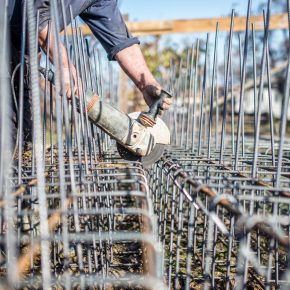
The Essential Role of Rebar in Construction
The construction industry heavily relies on the durability and strength of structures, which can be achieved by using proper materials and techniques during the building process. Reinforcement bars, commonly known as rebar, play a crucial role in creating sturdy and long-lasting buildings. This vital component in concrete structures acts as the backbone, enhancing tensile strength, preventing cracks, and ensuring the overall stability of the construction. What is the essential role of rebar in construction, and how significant is it for reinforcing the foundation?

Why is rebar important in construction?
Steel reinforcing bars, known as rebar, are used to support and strengthen concrete structures. These bars are placed within the concrete matrix to counteract its inherent weakness in tension. Concrete is known for its impressive compression capabilities, but it requires additional support and strengthening when it is subjected to pulling or stretching forces. By using rebar, a composite material is created that can withstand a variety of loads.
A wide range of reinforcement bars, mesh, and other accessories can be found at https://www.reozone.com.au
Enhancing tensile strength
Rebar plays a crucial role in construction by increasing the tensile strength of concrete – essential for reliability during construction. To put it simply, tensile strength refers to the ability of a material to withstand stretching or pulling forces without cracking or deforming.
While concrete is known for its robustness in construction, it lacks significant tensile strength. However, when rebar is used in combination with concrete, the composite material achieves impressive strength due to the high tensile strength of steel. This synergy greatly enhances the overall performance of the structure and construction.
Prevention of cracks and structural failures
Concrete structures may develop deep cracks which can pose a threat to the overall construction. To prevent this, the structural integrity should be improved. The use of rebar is an effective way to enhance the integrity and provide extra protection against cracks. This is especially important for high-volume structures that carry heavy loads.
Various weather conditions and the natural process of hardening and drying can cause concrete to shrink and crack. By using rebar inside the concrete construction, the cracking can be minimised as the rebar evenly distributes the load. This provides the concrete construction with robustness and reliability over a long period of time.
Effective distribution of loads
Buildings are subjected to various loads, which is why the support of concrete construction is required. One such load is the dead load caused by the weight of the structure. Live loads are flexible and may include people and furniture, which are usually beyond human control. It is not practical to limit the number of guests or the amount of furniture they bring to a building. Lastly, there are environmental loads caused by winds or earthquakes, which are also beyond human control.
All these loads and conditions endanger the stability of a structure, highlighting the need for robust design and construction. Rebar helps distribute loads evenly across the concrete structure and prevents localised points of stress that may lead to failure. Proper placement of rebar is essential to ensure that forces affecting the structure are distributed evenly, thereby ensuring the safety and stability of the construction.
Sustainability of constructions
It may seem unexpected to discuss the sustainability of buildings constructed with concrete, but when the longevity of the structures is taken into account, using rebar to reinforce the concrete can result in less maintenance and reconstruction work being necessary.
By incorporating rebar, the impact of environmental factors that cause corrosion and chemical exposure, leading to deterioration over time, can be minimised. Rebar also helps prevent cracks and failures, which can compromise the stability of the structure, by distributing the load and delaying the need for repairs.
Latest news

26th July 2024
Enfield Speciality Doors completes world-class project for Atlas Copco HQ
A rundown office and warehouse building completely transformed into a modern headquarters for Atlas Copco has been fitted with more than 120 internal fire doors from Enfield Speciality Doors.
Posted in Access Control & Door Entry Systems, Articles, Building Industry News, Building Products & Structures, Building Systems, Case Studies, Doors, Interior Design & Construction, Interiors, Posts, Restoration & Refurbishment, Retrofit & Renovation, Security and Fire Protection, Sustainability & Energy Efficiency, Timber Buildings and Timber Products, Wooden products
26th July 2024
Abloy UK launches new white paper
Abloy UK, a leading provider of security and access control solutions, has launched a new white paper.
Posted in Access Control & Door Entry Systems, Architectural Ironmongery, Articles, Building Industry News, Building Products & Structures, Building Services, Doors, Facility Management & Building Services, Health & Safety, Information Technology, Innovations & New Products, Publications, Research & Materials Testing, Security and Fire Protection
26th July 2024
MCRMA Member Profile: David Roy, Director of Roofconsult
David Roy of MCRMA member company Roofconsult has more than 50 years’ experience to draw upon working in the building envelope sector and a unique perspective on how it has changed in that time.
Posted in Articles, BIM, Infrastructure & CAD Software, Building Associations & Institutes, Building Industry News, Building Products & Structures, Building Services, Building Systems, Cladding, Information Technology, Restoration & Refurbishment, Retrofit & Renovation, Roofs, Walls
26th July 2024
Strand: Enhancing Door Functionality and Safety
Craig Fox, Sales Director for Strand Hardware, outlines how door industry professionals might apply door limiting stays…
Posted in Architectural Ironmongery, Articles, Building Industry News, Building Products & Structures, Building Services, Doors, Facility Management & Building Services, Health & Safety, Restoration & Refurbishment, Retrofit & Renovation
 Sign up:
Sign up: